8 Most Desired El Cazador Shipwreck Coins
Posted onWhen it comes to shipwrecks, few have had as profound an impact on shaping America’s history as El Cazador. This vessel’s story is not just one of maritime tragedy, but also of the extraordinary treasure it carried and the ripple effects of its loss. This piece will delve into the remarkable coin discoveries from this legendary vessel, exploring El Cazador shipwreck coin value, as well as:
- The captivating history of El Cazador.
- The consequences of the ship’s sinking.
- The premier destination for acquiring rare coins.
Watch an expert unveil clusters of silver coins salvaged from the El Cazador wreckage in this fascinating video:
Facts about El Cazador ship
Altering the course of American history, El Cazador holds a unique place in maritime lore. Discovered in 1993, this Spanish shipwreck serves as a poignant reminder of the profound impact of maritime trade on the development of the New World.
El Cazador ship model
Built in the late 18th century, El Cazador epitomized the Spanish brigantine — a hallmark vessel of the Age of Sail, prevalent in the 17th and 18th centuries for both naval and merchant ventures. Characterized by two masts, brigantines like El Cazador feature a towering mainmast alongside a subordinate foremast, each meticulously rigged with square sails attached to horizontal yards.
Additionally, these vessels often boast fore-and-aft rigged sails on the mainmast running parallel to the ship’s length. This dual rigging design not only bolsters propulsion but also enhances maneuverability, making brigantines versatile across diverse wind conditions and agile on the high seas.
El Cazador story
Known for its agility and versatility, El Cazador was a common sight along the trade routes of the Spanish Empire, ferrying goods and passengers across the vast expanse of the Atlantic Ocean. In the year 1784, the vessel was assigned a pivotal mission by the Spanish authorities: transporting a vital cargo of essential supplies and treasures, including hundreds of thousands of coins minted in Mexico City and other colonial mints, to bolster the economic prospects of the Spanish colonial authorities in Louisiana. Departing from the bustling port of Veracruz, Mexico, the ship embarked on a journey bound for the port of New Orleans.
With Captain de Campos y Pineda at the helm, the crew of El Cazador set sail with determination. The journey was fraught with challenges as the vessel navigated unpredictable waters and faced the ever-present threat of piracy lurking on the horizon. Despite the perils, the crew pressed on, driven by the promise of profit and the duty to serve their homeland.
However, as the ship ventured into the Gulf of Mexico, it encountered a fierce storm that proved to be its undoing. Notwithstanding the crew’s valiant efforts to weather the tempest, El Cazador ultimately succumbed to the fury of the sea, disappearing beneath the waves along with its precious cargo and the hopes it carried for the colony of Louisiana.
Passengers on El Cazador shipwreck
El Cazador served as a merchant vessel, primarily dedicated to transporting cargo rather than passengers. While there are no detailed historical records regarding passengers on the vessel, it’s possible a few merchants, cargo overseers, or Spanish colonial representatives were on board alongside the crew. Unfortunately, no survivors emerged from the tragedy of El Cazador’s sinking, leaving behind unanswered questions about its fate at sea.
El Cazador aftermath
The disappearance of El Cazador in 1784 had far-reaching consequences that reverberated across the Kingdom of Spain and the New World. The failure to locate the ship and its valuable cargo prompted Spain to relinquish control of Louisiana back to France in 1800. Subsequently, France sold the territory to the United States in 1803 for $15 million, significantly expanding American territory.
Some historians speculate that had the vessel successfully delivered its treasure to New Orleans, parts of the present-day United States might still be under Spanish sovereignty.
El Cazador shipwreck location
The wreckage of El Cazador was discovered in 1993 in the Gulf of Mexico, 50 miles southeast of New Orleans, by fisherman Jerry Murphy. While trawling for shrimp, Murphy hooked his net into an obstacle. This turned out to be a cluster of silver coins from El Cazador.
This chance encounter marked the beginning of the ship’s recovery efforts, which ultimately yielded a trove of artifacts, notably including a significant portion of the vessel’s cargo of Spanish colonial coins.
How many coins from Cazador ship are known
The coins retrieved from the El Cazador shipwreck unveil a window into the past, showcasing the bustling trade routes of yesteryears. Much like the Atocha shipwreck treasure, these coins offer tangible evidence of the thriving transatlantic trade during the colonial era, illuminating the economic exchanges that shaped the course of history.
1. 1783 8 Reales El Cazador coin
Created by the Mexican Mint and stamped with the assayer mark “F.F.”, this 1783 8 reales El Cazador Spanish wreck coin features the bust of the King of Spain Charles III on the obverse and the Hispanic arms design on the reverse. As the most common coin found among the wreckage, it is clear that it played a big role in shaping the economic landscape of the colonial era.
In fact, the use of this El Cazador shipwreck coin (“Spanish piece of eight” as it is often referred to) was so widespread in international trade during the 16th to 19th centuries that it became synonymous with the Spanish dollar and even served as legal tender in the U.S. until the Coinage Act of 1857.
1783 Carlos III 8 Reales
- Metal: Silver
- Year: 1783
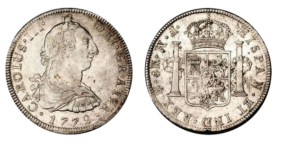
2. 1781 El Cazador shipwreck coin 8 Reales
One of the rarer finds among the 8 Reales coins recovered from the El Cazador shipwreck is this 1781 piece. Minted in Lima, Peru under the reign of King Charles III, this coin is distinguished by its scarcity. Compared to its counterparts minted in Mexico, there were far fewer coins produced in Lima, and consequently, fewer found on the ship, making them highly sought after by collectors. As a result, the El Cazador 8 reales coin value of these pieces remains significant.
1781 Carlos III 8 Reales
- Metal: Silver
- Year: 1781
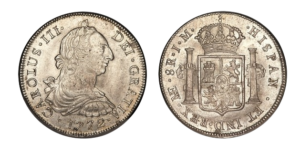
Photo by Numista
3. 1740 4 Reales El Cazador coin
Another fascinating El Cazador treasure coin is this 4 reales piece minted under the reign of Felipe V, a notable departure from the majority of coins on the vessel which were produced during Charles III’s reign. Distinguished by its unique design featuring a shield embellished with a regal crown on the obverse, this coin offers a captivating glimpse into Spain’s numismatic heritage during Felipe V’s rule.
1740 Felipe V 4 Reales
- Metal: Silver
- Year: 1740
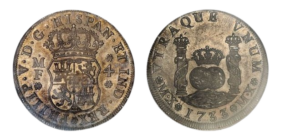
Photo by Numista
4. 1783 El Cazador 2 Reales coin
A striking find, this 2 Reales 1783 El Cazador shipwreck coin was among the most frequently discovered artifacts in the wreckage. These coins held particular popularity across the Spanish colonies, valued for their versatility in everyday transactions. Their lower denomination allowed for easy exchange in a variety of purchases, underscoring their widespread use in daily commerce.
1783 Carlos III 2 reales
- Metal: Silver
- Year: 1783
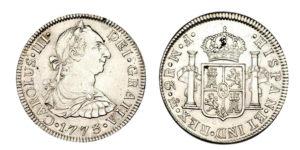
Photo by Numista
5. 1768 El Cazador 2 Reales silver coin
The 1768 Carlos III 2 Reales coin is a notable discovery among the wreckage of El Cazador, distinguished by its rarity compared to other 2 Reales coins recovered. What sets this coin apart is the presence of the assayer mark “FM,” unlike the more commonly found “FF” mark on coins from a similar period. This unique marking adds to the coin’s historical significance and makes it a prized find for collectors, contributing to its high “El Cazador coins value”.
1768 Carlos III 2 Reales
- Metal: Silver
- Year: 1768
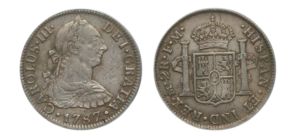
Photo by Numista
6. 1785 1 Real El Cazador silver coin
With a unique combination of design elements, this 1785 Carlos III 1 Real coin from El Cazador wreck is a prized addition to numismatic collections, reflecting the rich heritage of Spanish colonial coinage. The coin’s obverse is graced by an armored bust of Charles III, exuding regal authority, while a crowned arms shield flanked by pillars on the reverse symbolizes Spanish imperial strength.
1785 Carlos III 1 Real
- Metal: Silver
- Year: 1785
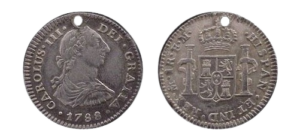
Photo by Numista
7. 1779 El Cazador shipwreck 1/2 Reale coin
As the second smallest denomination among Spanish colonial silver coins, half reales coins played a crucial role in everyday commerce throughout the colonies. This particular piece represents the most commonly found 1/2 reales El Cazador coins, distinguished by its assayer mark “FF.”
1779 Carlos III ½ Real
- Metal: Silver
- Year: 1779
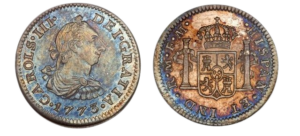
Photo by Numista
8. 1744 ½ Real coin from shipwreck El Cazador
A prized rarity among El Cazador half reale coins, this 1744 ½ Real coin is greatly sought after by collectors for its earlier date of minting and the presence of the assayer mark “FM” that sets it apart as a distinctive find. Produced during the reign of King Felipe V, this coin represents a less common variety among the wreckage, adding to its numismatic allure.
1744 Felipe V ½ Real
- Metal: Silver
- Year: 1744
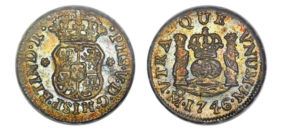
Photo by Numista
Browse a broader selection of rare coins beyond El Cazador coins for sale.
Where to buy rare coins
El Cazador played a pivotal role in shaping American history as a significant shipwreck. Its discovery revealed a treasure trove of valuable coins, each with its own compelling story, now highly sought after by collectors worldwide.
To begin or enhance your own numismatic journey with the acquisition of rare coins, trust Blanchard’s unmatched expertise and dedication to excellence. Do not hesitate to reach out to Blanchard’s team with questions about El Cazador shipwreck coins value and more. Blanchard’s expert numismatists are available to assist you at all times, ensuring a seamless and enriching numismatic experience.
Want to read more? Subscribe to the Blanchard Newsletter and get our tales from the vault, our favorite stories from around the world and the latest tangible assets news delivered to your inbox weekly.







